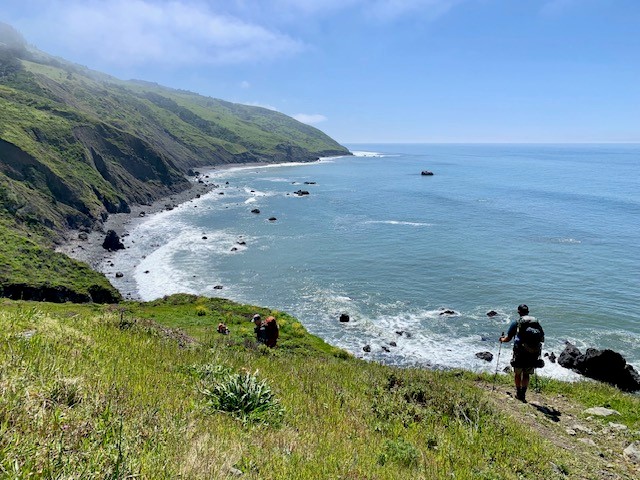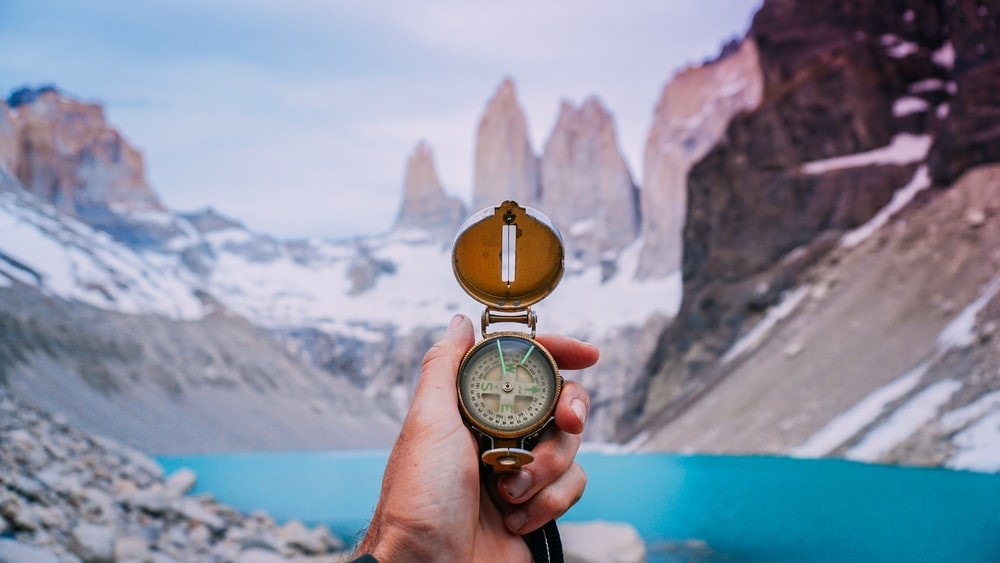Last week I checked off a bucket list trip by backpacking the Lost Coast—with two friends I’ve known for more than 20 years.
After living in California my entire life, this was yet another amazing area of California I’d never explored.
If you are not familiar with the Lost Coast, it is the longest roadless stretch of land in 48 states. The area was too costly for state builders to develop roads due to the rugged 4,000 foot peaks of the King Range, leaving it the most undeveloped and remote portion of the California coast. It was named after people mostly left this region in the 1930s. It is one of the few coastal backpacking experiences in the nation.
The area averages 100-plus inches of rain every year — most of which occurs between October and April — making it one of the wettest regions in the United States.
We got lucky with a very clear weather window during our trip, with zero rain.
We left late in the afternoon for the near 6-hour drive to the quirky, but beautiful town of Shelter Cove in Humboldt County—which has a population of just 500 people.
Despite it’s tiny size, the town has an airstrip, a 9-hole golf course overlooking the ocean, a general store, an RV park, a pizza window, coffee shop, and brewery. Deer, bear, and fox roam freely throughout the residential roads.
As we drove through town I pondered what might cause someone to move to a place like this, and what daily life was like.
The trail
To hike the classic Lost Coast, we had to leave our car at the southernmost end of the trail and hire a shuttle company to drive us 2 hours north to the trailhead.
During our bumpy and very winding ride on mostly dirt roads, several carsick passengers sat in total silence clearly putting all their focus into not throwing up, while we listened to the strange and colorful historical narrative of the area from our garrulous van driver.
Our driver—I’ll call him Scott—had moved here a few years ago from Philadelphia to live in some cabins that a friend of his from elementary school owned.
Scott told us about the Native tribes who originally lived here, along with European sheep-herding immigrants who came almost 100 years ago.
He shared that prior to the recent laws around cannabis, the Bulgarian Mob and Cartels had operated in the region, leading to higher violent crime rates until about 5 years ago. He pointed out California’s first medical cannabis farm as we drove by, along with a bizarre piece of local artwork—an old blue pickup suspended from the redwood trees about 40 feet off the ground—complete with surfboards in the truck bed.
We arrived at rustic Mattole campground thinking we might not find a campsite on a Friday afternoon, but were pleasantly surprised to find only three campsites occupied that night.
We took a day hike up the closest peak and a long stroll on the dunes, finding explosive wildflowers and very few people.
The next morning we woke to tents soaking from the dew, dried them in the early sun, and began our hike about 8:30am.
My soul was in a rare complete state of calm, taking in the black sand, striking green peaks, and ocean air. My senses were completely alive with sounds of sea lions, birds chirping, and the rhythmic pulsing of large waves crashing on the beach. In rocky sections, you could hear the subtle change of the sound when the rocks rolled back over one another.
Eric walked along the waterline with his SLR camera, stopping occasionally to snap a photo.
Mark was often quiet, probably trying to purge some of his most recent season of extremely hard work and long hours growing his business.
After spending decades sometimes hiking many thousand feet per day in the Sierra, we all agreed later that we had mistakenly underestimated the difficulty of carrying a 40-pound pack while walking in deep sand, scrambling over rocks, and forging the frequent creeks that ran into the ocean.
We approached Punta Gorda lighthouse to find a large colony of elephant seals scattered across the hiking trail. They had apparently scrambled up the small cliffs to nap in the grass.
We gave them a wide berth after receiving warnings that they can grow up to 4500 pounds and could be aggressive if startled.
One very important thing to know about hiking the lost coast is that it contains three impassable tide zones. Two of them are four miles long with very few bail-out opportunities. Since you are often walking on a beach with large cliffs, we had to carefully study the incoming and outgoing daily tide tables to ensure we had enough time to walk through the zone without it being completely flooded by sea water. Hikers have mistakenly walked into these zones and been swept out to sea.
We spent the next several hours sometimes in great conversation about life, and sometimes in silence just letting our minds wander and taking in the scenery.
After about 11 miles, we set up camp around 3pm at Spanish Creek, gathered some drift wood (for a legal fire), and set up our tents on the beach.
We rested our feet which already had some decent blisters from the shifting sandy terrain. That evening I pulled out my small JBL speaker while we sat by the fire, cooking and staring at the ocean.
The sun set over a fog bank about 20 minutes early, creating a very cool visual effect of double horizon. But the quintessential moment of that day was the group of small whales spouting in the early moonlight of the nearly full moon.
In case you were wondering, there are no bathrooms so the state instructions are to dig a hole below the high tide line, pack out your toilet paper, and pray no one else is on the beach when your biological rhythms strike! There are, after all, no trees to discreetly hide behind on the beach.
After a very windy night, we had a leisurely talk over coffee and breakfast, bandaged our feet carefully, and started hiking around 9am.
We spent the day in vast fields of California poppy’s, walking on the beach, and sometimes scrambling up the steep cliffs. I caught a short shower under one of many waterfalls, and a quick swim in a deeper section of creek at Miller’s flat.
We saw only a handful of other backpackers that day.
A slight detour cost us about a mile before we crossed the final four-mile tide zone to reach Gitchell Creek, where we had planned to camp for the night.
After setting our packs down for a moment, my two friends pitched the idea of hiking a little further, to save us some time the next morning hiking out.
We all agreed, and following a short rest, decided to hike a bit further.
We stopped for only a fleeting glance at the next tenting area, but when you can see the pizza place and brewery from your campsite, it may have been a non-verbal decision to hike the remaining three miles to the car. This made for a 17-mile hike that day and very sore feet.
We grabbed a great meal at the Gyppo Mill that night and walked about 100 feet from the restaurant back to our tents at the RV park for an early night.
The trip was a total system reboot and I returned relaxed, focused, and energized.
Turn information into action
Ancient wisdom and current research both reflect that we need breaks from the frantic pace of modern life.
We need rest and recovery daily, weekly, and yearly.
For our brain and nervous system to recover, and function at their best, we must do all three consistently.
Here are a couple great studies that support this:
- 90% of people say a lunch break boosts productivity. In a 2018 Forbes article entitled, Employee Engagement and the Long-Lost Lunch Break, 90% of survey participants said a lunch break (with healthy activities) increased productivity, well-being, job engagement, job commitment, and creativity. Other studies have shown that people need a break about every 50 minutes.
- People who unplug one day per week live an average of 10 years longer. In the famous Blue Zones research by National Geographic, they found only 7 regions of the world where people regularly live past the age of 100. One such area was Loma Linda California, where they believed that residents lived longer because of practicing a regular Sabbath day of rest once a week. Netflix released a series on this research this year.
- People are more likely to get a raise or bonus if they take a 10+ day vacation per year. In the 2016 HBR article by Harvard researcher Shawn Achor entitled The Data-Driven Case for Vacation, they found that people who took less than 10 vacation days per year had a 34.6% chance of receiving a raise or bonus in the next three years, while those that took 10+ days had a 65.4% chance.
All of these studies are compelling, but I will never forget something I read by Henri Nouwen many years ago.
He said that when we eliminate silence and rest from our lives, we eliminate the voice of God, and access to deeper inner wisdom.
What happens in your life when you don’t rest?
What happens when you eliminate all quiet spaces from your life?
Take some time this weekend to ponder or assess yourself in these areas.
Have a great weekend!
Parker
Want more resources?
- Sabbath by Wayne Mueller
- Margin by Richard Swenson
- Rest by Alex Pang




